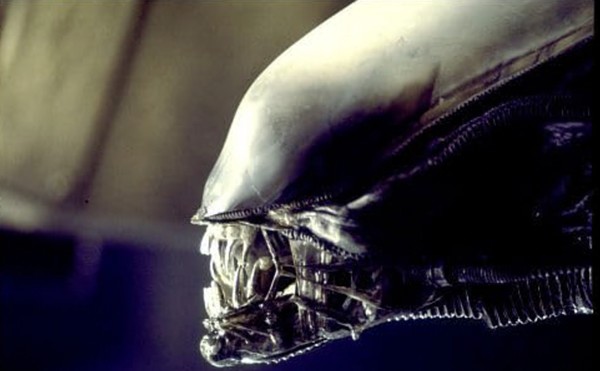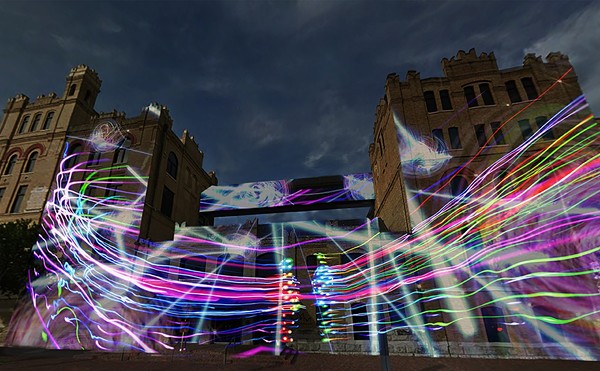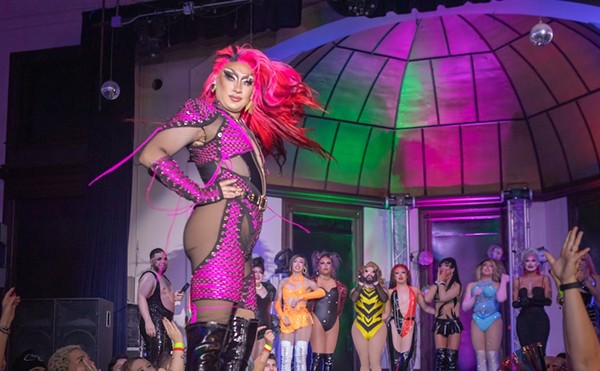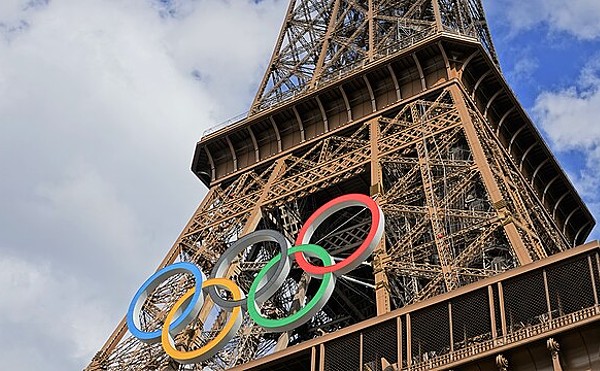Celebrating the opening of the River Walk’s new Museum Reach, curator David Rubin — thirsting for a popular audience with this easy-to-swallow theme exhibit — has gathered 15 local artists who contemplate the importance of the liquid combination of hydrogen and oxygen in Waterflow at the San Antonio Museum of Art.
Though jammed in the small Focus Gallery, with competing soundtracks for videos alongside more traditional paintings, Waterflow is a peaceful, easy kind of show, enhanced by bird calls and the rippling, gurgling sounds of running water. Several of these pieces have been exhibited before, but the elusive, transparent nature of water, which is never quite the same twice, is the source not only of nourishment, but also rich visual metaphors concerning the transience of life.
Penelope Speier’s video “Writing on Water” is lyrical and elegant, and inspired by her visit to a Buddhist temple in Kyoto, Japan. While the river flows swiftly past, the artist’s hand dips a calligraphy brush into the stream, spelling out words carried away before they can form. This is probably the show’s best illustration of the concept of flux by the Greek philosopher Heraclitus that Rubin mentions in his catalog essay, though it was actually Plato who said we “cannot step twice in the same river.” But while the water flowing through the river changes, the river remains the same.
The passage of time is also an important element of Leslie Raymond’s simple yet soothing video, “Michigan (Reflecting Pool).” Using time-lapse photography, she filmed a pan of water with birds and other barely glimpsed animals drinking from it — the surface of the water reflects trees, clouds, sky, and sunlight. Raymond considers her work a contemporary version of traditional landscape painting, with changing kinetic pixels instead of brush strokes frozen for eternity.
Justin Boyd evokes the spirit of Huckleberry Finn in “Meditation on a North Flowing River,” a raft with a sail-like projection screen that he showed as part of the Texas Art Prize competition at Austin’s Arthouse. Based on a trip he took on the Mississippi River, it is accompanied by a minimalist soundtrack of electronic hisses and burbles that he created from his grandparents’ record collection.
Most of the bird calls and water noises emanate from Andy Benavides’s mechanical yet blissful “White-bellied Swallows,” in which translucent plastic strips decorated with wavelike lines of blue rotate on metal rollers. The silhouettes of a pair of birds appear to be kissing in this playful homage to the greatest bird painter of them all, John James Audubon.
Only two pieces in the show are overtly political. Liliana Wilson’s “Greed II” depicts a pair of fish-headed men wearing business suits, who are trying to push the heads of a man and woman under water in a blood-red river. Wilson said the painting is about the struggles of Mexican immigrants trying to swim the Rio Grande — “these people know once they are caught, there is nothing they can do about it.”
Pollution is the theme of “Progress,” a collaboration of Laura Varela and Guillermina Zabala, which features the silhouette of a pregnant woman. Her stomach contains a video of trash strewn along the San Antonio River. Her body is outlined by written notations, including “In caring for our mother we care for ourselves.” The cacophonic background includes notations about “Bush supporters,” with the multi-million dollar amounts donated to the ex-President’s campaign by major corporations such as Philip Morris, Lockheed Martin, and Enron. Is pollution the natural accompaniment of progress? Varela and Zabala seem to think that President Obama is showing a different way that combines compassionate capitalism with “green” goals.
Water’s abstract qualities are captured in photographs by Ansen Seale and Mark Menjivar. Seale used a “slitscan” panoramic camera of his own invention, recording a sliver of running water over a long period to time to produce the spectrograph-like bands of color in “Hellroaring Creek No. 13.” Menjivar’s “Aguas Series” consists of black-and-white photographs of the patterns formed by swirling foam in a favorite swimming hole.
Nate Cassie uses mathematical formulas to simulate the effects of water in motion in his abstract “Deluge Series” paintings, while Liz Ward’s small “Crazy Weather” paintings are inspired by aerial views of the currents that cause giant floating islands of trash to form in the middle of the Pacific Ocean.
The videos do the best job of capturing water’s transient nature, and Waterflow might be a splashier exhibit with fewer artists. These pieces also have to compete with the lighted elevator in the Focus Gallery, which has never been conducive to contemplative shows. SAMA needs a much larger changing exhibit space to cope with the diversity of contemporary art, especially the sound and light of video, which really requires isolated, darkened galleries.

















